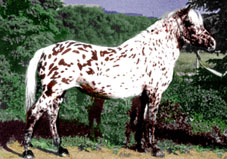Altai
N/A
Wed, 20th November, 2024 - 7:34 am GMT
Sponsor Ads:

Alternative Name
N/ABasic Info
Altai's head is average in length, large and somewhat coarse, and the neck is fleshy while the back is long and slightly dipped. Their croups are well-developed and their legs are short and properly set. Occasionally defects crop up, including sloping pasterns and bowed hocks. They can be chestnut, black, bay, gray, and sometimes spotted.
Health
N/AHabitat
Altai mountainsBehavior
The Altai horse was developed over a long period of time, and has been significantly influenced by the harsh climate and the conditions specific to the mountains in which they make their home. The Altai is adapted to year-round pasture grazing, and the Altai crosses with pure breeds have a good performance. They are larger, more massive, and stronger than the Altai while retaining the sound health and undemanding demeanor of the Altai. Programs are underway to develop a new meat producing breed by crossing the Altai with the Lithuanian, Russian, and Soviet Heavy Draught. These crossings were made after the revolution as well as under the Soviet government. Henceforth the crossbred horses were bred "in Purity". This breed was reared in the Altai mountains for many centuries and are very well adapted to its harsh environment. Horses have always been important to the tribesmen and nomads in the mountainous region, requiring horses with a strong heart, lungs, muscles, and tendons in addition to very hard, tough feet. A surefooted horse is imperative, because they must often travel over steep mountain trails cut from the rock and also cross fast-moving streams without slipping. The Altai is a very hardy animal that is indispensable to the people who depend on it.Origin
SiberiaHistory
The Altai originated from the Altai Mountains and are well used to its harsh environment. The Altai have adapted from being reared in these mountains and have strong heart, lungs, muscles, and tendons. They are sure-footed and able to traverse up steep mountain trails, across moving streams or rivers, and negotiate dangerous rocky paths. These horses have always been important to the tribesmen and nomads of this mountainous region. The Altai were developed over a long expanse of time and have been significantly influenced by the harsh continental climate and the conditions specific to the mountain taiga which they call home. In the typical Altai the head is average in length, large and somewhat coarse; the neck is fleshy; the back is long and slightly dipped; the croup is well developed, the legs are short and properly set. Occasional defects in conformation include sloping pasterns and bowed hocks. The average measurements (in cm) are: stallions - height at withers 140, chest girth 170, cannon bone girth 19; mares: 137, 170 and 18 respectively. The colors are chestnut, bay, black and gray, sometimes spotted. The Altai is a hardy animal that is easy to care for and are in pasture year round for grazing. The Altai are often crossed with pure breed horses to produce a larger breed while maintaining its health and relatively easy maintenance. The Altai are essential to the people who rely on them. The Altai is highly adapted to year-round pasture grazing. Altai crosses with pure breeds have a good performance. They are larger, more massive and stronger than the Altai while retaining their sound health and are undemanding as regards their management. Activities are underway to develop a new meat producing breed by crossing the Altai with the Lithuanian, Russian and Soviet Heavy Draft. These crossings were made after the revolution as well as under the Soviet government, and then the crossbred horses were bred "in purity." Altai - "The Golden Mountains" is the mountain land on the south of Siberia which keeps ecological purity and untouched wild nature so far. This breed were reared in the Altai Mountains for many centuries and are well adapted to its harsh environment. Horses have always been important to the tribesmen and nomads in this mountainous region, requiring horses with a strong heart, lungs, muscles, and tendons along with very hard feet. A sure-footed horse is important, as they must travel over steep mountain trails cut from the rock and cross fast-moving streams and rivers. The development of the Altai has resulted in the creation of a hardy animal which is indispensable to the people who depend on it. The Siberian horse is bred on huge country/area from the Eastern slopes of the Ural mountains to the river Yenisei, in the northern and eastern Siberia, in the purebred form of the Mongolian type; there are recognized several indigenous types not well known to the public. All of them are offering to their owners their strength, speed with endurance, meat, fat, milk, fur/hair for “twines” and skin for coats, because in the winter they grow very long and thick coat/hair. The most valued from the southern Siberian horses is the Altai horse, who is in the bone structure stronger than the Kirgiz horse; he is excellent (soumar) pack horse, has very solid back, solid and strong legs and hoofs, and very undemanding in feed and care; he easily caries on his back the weight of 150 kg (330 pounds) during long trips in the high mountain terrain. The northern Siberian horses are bred under very harsh living conditions; in the cities of Tomsk, "Stalinogorsk" and others are conducted races of 3,200 m (2 miles) in length, which these horses will run in the time of 4 minutes and in trot in six minutes.Common Foods
grassSponsor Ads:
"The whole of science is nothing more than a refinement of everyday thinking." -- Albert Einstein
Altai
Coded by: BGID® | ALL RIGHTS RESERVED Copyright © 2000-2024
Disclaimer | Privacy | Report Errors / Contact | Credits
















